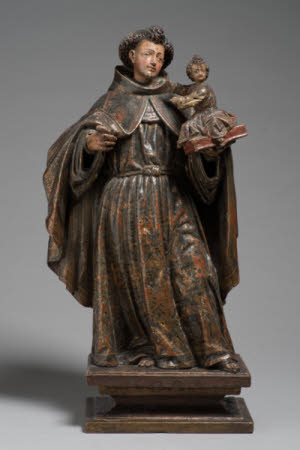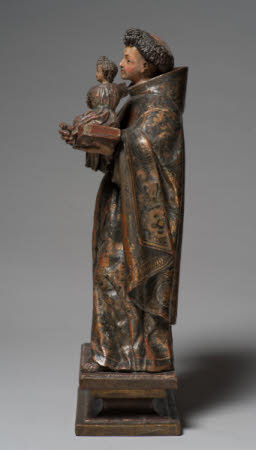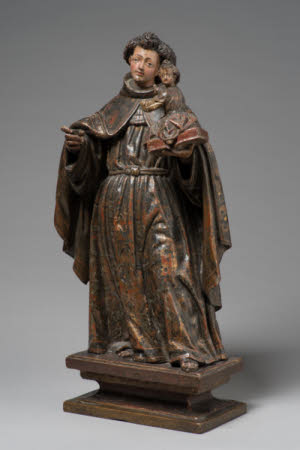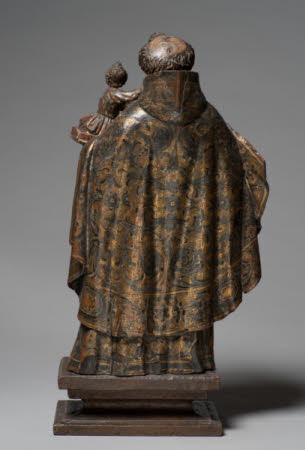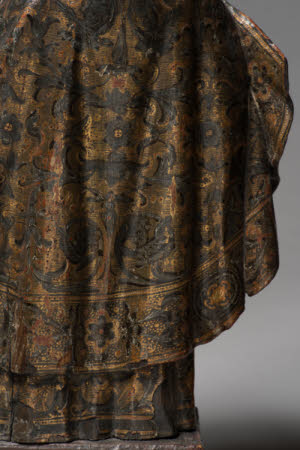St Antony of Padua with the infant Christ
Spanish School
Category
Art / Sculpture
Date
c. 1650 - c. 1750
Materials
Wood, gesso, gilding, paint
Measurements
620 mm (Height)
Place of origin
Italy
Order this imageCollection
Anglesey Abbey, Cambridgeshire
NT 514446
Summary
Wood, gesso, gilding, paint, St Antony of Padua with the infant Christ, Spanish or Spanish Colonial School, c. 1650-1750. A Spanish or Spanish Colonial statue of Saint Antony of Padua (1195-1231) holding the infant Christ, who is seated on a book balanced on Antony’s left hand. He is dressed in a heavy tunic with a belt knotted at waist, over this a heavy pilgrim’s cloak with hood, that bunches at the sleeves. Antony now hold a modern palm Cross in his right hand. The sculpture is polychromed, the clothes richly painted and gilded. The surfaces of the draperies have been worked in a technique known as estofado, in which a layer of gold leaf is overlaid with pigments, that are then scratched away using tools, to produce patterns with a brocade effect. Some losses, including Christ’s left hand, right toes and part of right hand. Mounted on a stepped wooden pedestal, set upon black marble base.
Full description
Saint Antony of Padua (1195-1231 A.D.) was born in Lisbon; after joining the Franciscan order, he became a friend and disciple of Saint Francis of Assisi, and the most notable of that saint’s followers. After establishing a great reputation for his learning and preaching abilities, he died in Padua at the age of just 35. He is the patron saint of Padua, Lisbon and other cities. Famous for his devotion to the poor, Antony has long been one of the most popular Christian saints, not least in the wider Catholic world beyond Europe. Since the 17th century he has been prayed to as the saint of lost articles. He is seen here with the infant Christ, who balances on a book. The book, referring to his learning, is one of the saint’s main attributes, whilst the figure of Christ refers to a vision of the Virgin and the Christ Child to Antony in his cell. The statuette at Anglesey would probably originally have had a lily, symbolic of purity, in the saint’s right hand. The intensity of the composition and the rich painted and gilded decoration are characteristic of Iberian sculpture. The figure was probably made sometime around 1700. It is similar in form and iconography to a larger statue of the saint in the Indianapolis Museum of Art, dating to the 18th century (Susan L. Stratton, ed, Spanish Polychrome Sculpture 1500-1800 in United States Collections, exh. cat., Spanish Institute New York, etc., 1993-94, p. 161). It is also possible that it was in fact made not in Spain but within the Spanish territories in Central or South America, compare a Hispano-American statue of St Francis of Assisi from c. 1700 in the Victoria & Albert Museum (Marjorie Trusted, Spanish Sculpture. Catalogue of the Post-Medieval Spanish Sculpture in the Victoria & Albert Museum, London 1996, pp. 138-39, no. 66). Jeremy Warren 2020
Provenance
Acquired by Huttleston Rogers Broughton, 1st Lord Fairhaven (1896-1966); listed in the Anglesey Abbey inventory of 1940, p. 75, Main Landing and Stairs, valued at £14; bequeathed by Lord Fairhaven to the National Trust in 1966 with the house and the rest of the contents.
Credit line
Anglesey Abbey, The Fairhaven Collection (The National Trust)
Makers and roles
Spanish School, sculptor Spanish Colonial, sculptor previously catalogued as by Italian (North Italian) School, sculptor
References
'Anglesey Abbey, Lode, Cambridgeshire. An Inventory and Valuation of Furniture, Books, Ornamental Items & Household Effects .. prepared for Insurance Purposes’, Turner, Lord and Ransom, April 1940, p. 75. Christie, Manson & Woods 1971: The National Trust, Anglesey Abbey, Cambridge. Inventory: Furniture, Textiles, Porcelain, Bronzes, Sculpture and Garden Ornaments’, 1971, p. 134. Russell 2007: Joanna Russell, ‘Anglesey Abbey Sculpture Project’, Hamilton Kerr Institute, University of Cambridge, 2007, pp. 28-30, Pl. 8, Appendix, pp. 32-37.
